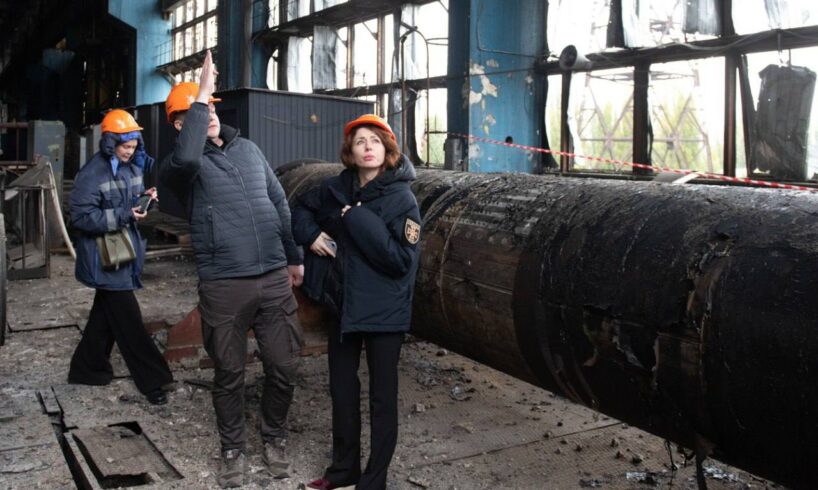
A massive Russian attack pummeled Ukraine’s energy and port infrastructure on Oct. 22 as Moscow shows no sign of slowing down its plan to freeze out Ukrainians as winter draws closer.
Emergency power outages were implemented in most regions of the country throughout the day as energy workers battled to repair damaged infrastructure, in some cases while still under bombardment. It’s become an all too familiar routine for many energy workers in recent weeks, as Russia ramped up its strikes in early October ahead of Ukraine’s heating season.
Starting late on Oct. 21, and lasting until well into the morning, Russia hit energy facilities across Ukraine, including in Kyiv and the surrounding region, Zaporizhzhia, Dnipropetrovsk, Cherkasy, Kirovohrad, Poltava, Chernihiv, Sumy, and Odesa oblasts, Ukrainian officials said.
The most critical situations are in Chernihiv and Sumy oblasts, which border Belarus and Russia, as well as Odesa and Kharkiv, Ukraine’s Deputy Energy Minister Artem Nekrasov said on television. Around 140,000 consumers were left without power in Chernihiv during the afternoon.
Ukrainska Pravda recently reported that Russia is trying to shut down energy flows region by region. Border regions in Ukraine’s north and east are currently the most vulnerable to energy instability, as Russia has decimated the local energy generation.
“We are forced to transmit large volumes of electricity from the western and central regions through a network that has itself been weakened by enemy strikes on substations and high-voltage lines,” Olena Lapenko, president of Dixi Group, an energy think tank, told the Kyiv Independent on Oct. 20.
“Sometimes there is enough generation available in the system, but due to enemy attacks, it is physically impossible to deliver electricity to a specific area, which leads to local shortages.”
DTEK, Ukraine’s largest private energy company, said that its workers had managed to connect 14,200 homes to backup power after one of its facilities was hit in Odesa Oblast, although it gave no further details about what was hit.
Energy companies are keeping tight-lipped about the details of recent attacks due to security concerns amid expanding and more precise Russian strikes.
Russia is employing “double-tap” attacks, the Energy Ministry said, which involves striking the same facilities repeatedly after first responders have arrived on site. With the “double-tap” strikes, they are “hunting” energy workers and first responders, the ministry added.
In Izmail, Odesa Oblast, aerial attacks left thousands without power and damaged the city’s port infrastructure, the Izmail District State Administration wrote on Facebook. The Izmail port is located on the Danube River and sees relatively small volumes of transhipments compared to the seaports in Odesa.
“Russia is trying to destroy the export-oriented economy and the tax-paying enterprises that finance our defense spending,” Serhiy Vovk, director of the Center for Transportation Strategies, a consultancy, told the Kyiv Independent.
Russia just hit a kindergarten in Kharkiv
Russia attacked Kharkiv with drones on Oct. 22, damaging a kindergarten and killing one person, injuring at least six, local authorities reported.
In Poltava Oblast, direct strikes and falling debris damaged oil and gas industry facilities, according to the governor of the oblast, Volodymyr Kohut. Russian strikes on Oct. 3 and 5 reportedly damaged around 60% of Ukraine’s gas production.
Ukraine is bracing for another winter of blackouts as much of its energy infrastructure remains unprotected from aerial attacks. If outages become more frequent, it could further harm the country’s already struggling economy.
“Power outages increase the cost of electricity for businesses. Consequently, production costs are rising and inflationary pressure is intensifying,” Nataliia Kolesnichenko, a senior economist at the Center for Economic Strategy, told the Kyiv Independent on Oct. 10, following previous Russian strikes.
“Lower electricity production volumes will lead to lower output in the energy sector, resulting in a negative impact on gross domestic product,” she said.
Businesses are much better prepared now than in October 2022 when Russia’s strikes on energy caught Ukraine off guard, so the economic hit is unlikely to be as bad, she said. However, if the energy security situation deteriorates, then economic losses will pile up, she added.
The attacks could also “further exacerbate” Ukraine’s humanitarian crisis, particularly for people living in front-line regions, the United Nations High Commissioner for Refugees (UNHCR) press office told the Kyiv Independent on Oct. 10.
The organization has already noted an uptick in people fleeing front-line areas over the summer, which could worsen over the coming months with power and water outages.
Ukraine strikes Russian chemical plant with Storm Shadow missiles, military says
The Bryansk Chemical Plant produces gunpowder, explosives, and rocket fuel components for the Russian military. It has been sanctioned by the U.S. and U.K.





